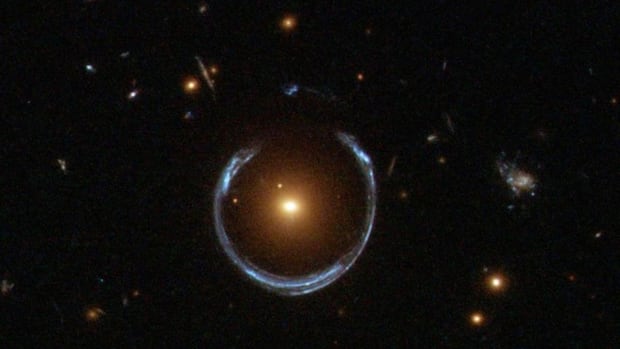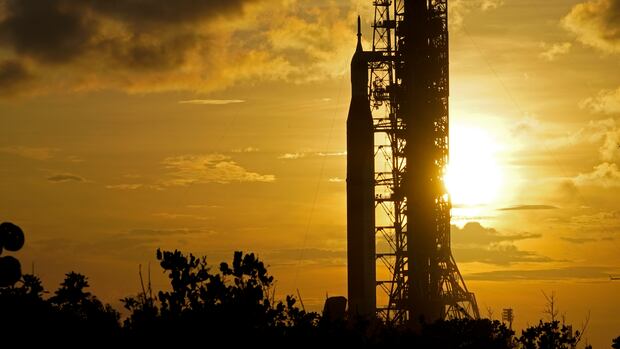Astronomers have discovered what they say is among the most massive black holes ever detected.
The cosmic behemoth is close to the theoretical upper limit of what’s possible in the universe, and is 10,000 times heavier than the black hole at the centre of our own galaxy.
It’s also 35 billion times as large as our sun, which makes it able to be classified as an ultramassive black hole.
Carlos Roberto de Melo-Carneiro, who discovered the black hole, told CBC News it was “among the most massive black holes ever measured.”
He says it’s also another key to understanding how black holes are formed and how they can be studied in the future.
An ultramassive black hole
This is actually Melo-Carneiro’s first research involving black holes. The PhD student at Universidade Federal do Rio Grande do Sul in Brazil is the lead author of the study about it published on Thursday, and found it when looking at dark matter in the galaxy.
His initial plan was to learn about how dark matter and galaxies evolve in the Cosmic Horseshoe system five billion light years away.
This black hole was likely created by galaxies containing supermassive black holes colliding and merging. Melo-Carneiro said researchers can usually estimate the mass of black holes based on the mass of the galaxies, but this one was more massive than they expected.
He says this is important because it allows them to gain further insight into how other massive black holes will form and what might happen to them in the future.
There are other massive black holes out there, such as TON 618, which NASA says is 66 billion times the sun’s mass and about 10 billion light years away.
Melo-Carneiro says he isn’t claiming that what they found is bigger, simply that it’s one of the biggest ever recorded, and another piece of the puzzle to understand ultramassive black holes and how they work.
“Most of the other black hole mass measurements are indirect and have quite large uncertainties, so we really don’t know for sure which is biggest,” said University of Portsmouth professor Thomas Collett, Melo-Carneiro’s supervisor and one of the paper’s authors, in a media release.
“However, we’ve got much more certainty about the mass of this black hole thanks to our new method.”

New methods, existing technology
Melo-Carneiro said that, traditionally, black holes are measured using the motion of the stars. The more massive the black hole, the faster the stars move around it.
However, this technique is more accurate for nearby galaxies, so he combined it with another method called gravitational lensing — looking at how the light from a distant galaxy is bent and distorted by the gravity of the black hole.
“The new thing with our method and our work is that we use both to improve our measurements of the black hole,” he said.
“This is something very new that as far as I know no one else has done before.”
The research also used 2014 data from the Hubble Telescope and 2017 data from the Very Large Telescope in Chile, meaning they had multiple ways of verifying their findings.
“I really appreciate it when scientists use complementary methods like this to validate their findings and make their science more secure,” said Daryl Haggard, an associate professor of physics at McGill University and a Canada Research Chair in Multi-Messenger Astrophysics, in an email to CBC news.
“Not every ‘biggest of’ result merits our attention, but we have struggled for a long time to understand how supermassive black holes grow and, in particular, how they grow so quickly.”
Melo-Carneiro is far more confident in the research thanks to this new method. One benefit is that it can measure “dormant” black holes like the one he found — which aren’t actively growing and colliding — and involves fewer assumptions about how galaxies operate.
The Milky Way’s black hole also considered dormant, but he says there are big size differences between ours and the Cosmic Horseshoe system.
“I’ll not say that we can learn about our future, but we can indeed learn about the future of other massive galaxies in the universe.”
Not surprising to some
Priyamvada Natarajan is a theoretical astrophysicist and the Joseph and Sophia Fruton Professor of Astronomy and Physics at Yale University.
She said she was excited to hear about the recent discovery but wasn’t all that surprised, since ultramassive black holes are something she predicted in her 2009 paper.

Natarajan explained that there is a correlation between the size of galaxies and the size of the black holes within them. There are also typically two ways black holes get bigger, repeated collisions with other galaxies that merge the black holes or by being fed gas so they can grow.
In that paper, she coined the term “ultramassive black hole,” and says that this one fits within what is predicted in her research and the equations she developed during it.
While she says it’s not an outlier, Natarajan says the implications of this discovery for black hole research are that it might prove to be a powerful method to find black holes and measure their mass.
“I think it tells us that we may want to start looking for more and more of these systems,” she said. “They’re powerful in terms of telling us more about how matter is heaped in the centre of these galaxies.”







